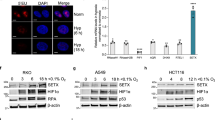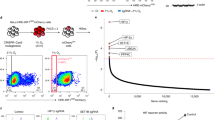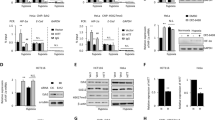Abstract
Tumor hypoxia has been reported to cause a functional loss in DNA mismatch repair (MMR) system as a result of downregulation of MMR genes, although the precise molecular mechanisms remain unclear. In this study, we focused on the downregulation of a key MMR gene, MLH1, and demonstrated that hypoxia-inducible transcription repressors, differentiated embryo chondrocytes (DEC1 and 2), participated in its transcriptional regulation via their bindings to E-box-like motif(s) in MLH1 promoter region. In all cancer cell lines examined, hypoxia increased expression of DEC1 and 2, known as hypoxia-inducible genes, but decreased MLH1 expression in an exposure time-dependent manner at both the mRNA and protein levels. Co-transfection reporter assay revealed that DEC1 and, to greater extent, DEC2 as well as hypoxia-repressed MLH1 promoter activity. We further found that the action was remarkably inhibited by trichostatin A, and identified a possible DEC-response element in the MLH1 promoter. In vitro electrophoretic gel mobility shift and chromatin immunoprecipitation assays demonstrated that DEC1 or 2 directly bounds to the suggested element, and transient transfection assay revealed that overexpression of DEC2 repressed endogenous MLH1 expression in the cells. Hypoxia-induced DEC may impair MMR function through repression of MLH1 expression, possibly via the histone deacethylase-mediated mechanism in cancer cells.
This is a preview of subscription content, access via your institution
Access options
Subscribe to this journal
Receive 50 print issues and online access
$259.00 per year
only $5.18 per issue
Buy this article
- Purchase on Springer Link
- Instant access to full article PDF
Prices may be subject to local taxes which are calculated during checkout





Similar content being viewed by others
References
Bindra RS, Gibson SL, Meng A, Westermark U, Jasin M, Pierce AJ et al. (2005). Hypoxia-induced down-regulation of BRCA1 expression by E2Fs. Cancer Res 65: 11597–11604.
Bindra RS, Glazer PM . (2006). Repression of RAD51 gene expression by E2F4/p130 complexes in hypoxia. Oncogene 26: 1–10.
Bindra RS, Glazer PM . (2007). Co-repression of mismatch repair gene expression by hypoxia in cancer cells: role of the Myc/Max network. Cancer Lett 252: 93–103.
Bindra RS, Schaffer PJ, Meng A, Woo J, Måseide K, Roth ME et al. (2004). Down-regulation of Rad51 and decreased homologous recombination in hypoxic cancer cells. Mol Cell Biol 24: 8504–8518.
Brown JM, Giaccia AJ . (1998). The unique physiology of solid tumors: opportunities (and problems) for cancer therapy. Cancer Res 58: 1408–1416.
Cairns R, Papandreou I, Denko N . (2006). Overcoming physiologic barriers to cancer treatment by molecularly targeting the tumor microenvironment. Mol Cancer Res 4: 61–70.
Denko NC, Fontana LA, Hudson KM, Sutphin PD, Raychaudhuri S, Altman R et al. (2003). Investigating hypoxic tumor physiology through gene expression patterns. Oncogene 22: 5907–5914.
Fujimoto K, Shen M, Noshiro M, Matsubara K, Shingu S, Honda K et al. (2001). Molecular cloning and characterization of DEC2, a new member of basic helix-loop-helix proteins. Biochem Biophys Res Commun 280: 164–171.
Harris AL . (2002). Hypoxia-a key regulatory factor in tumour growth. Nat Rev Cancer 2: 38–47.
Hoeijmakers JHJ . (2001). Genome maintenance mechanisms for preventing cancer. Nature 411: 366–374.
Honma S, Kawamoto T, Takagi Y, Fujimoto K, Sato F, Noshiro M et al. (2002). Dec1 and Dec2 are regulators of the mammalian molecular clock. Nature 419: 841–844.
Ivanova AV, Ivanova SV, Danilkovitch-Miagkova A, Lerman MI . (2001). Regulation of STRA13 by the von Hippel–Lindau tumor suppressor protein, hypoxia, and UBC9/ubiquitin proteasome degradation pathway. J Biol Chem 276: 15306–15315.
Ivanova SV, Salnikow K, Ivanova AV, Bai L, Lerman MI . (2007). Hypoxic repression of STAT1 and its downstream genes by a pVHL/HIF-1 target DEC1/STRA13. Oncogene 26: 802–812.
Kawamoto T, Noshiro M, Sato F, Maemura K, Takeda N, Nagai R et al. (2004). A novel autofeedback loop of Dec1 transcription involved in circadian rhythm regulation. Biochem Biophys Res Commun 313: 117–124.
Koshiji M, To KKW, Hammer S, Kumamoto K, Harris AL, Modrich P et al. (2005). HIF-1alpha induces genetic instability by transcriptionally downregulating MutSα expression. Mol Cell 17: 793–803.
Li Y, Xie M, Song X, Gragen S, Sachdeva K, Wan Y et al. (2003). DEC1 negatively regulates the expression of DEC2 through binding to the E-box in the proximal promoter. J Biol Chem 278: 16899–16907.
Mihaylova VT, Bindra RS, Yuan J, Campisi D, Narayanan L, Jensen R et al. (2003). Decreased expression of the DNA mismatch repair gene Mlh1 under hypoxic stress in mammalian cells. Mol Cell Biol 23: 3265–3273.
Miyazaki K, Kawamoto T, Tanimoto K, Nishiyama M, Honda H, Kato Y . (2002). Identification of functional hypoxia response elements in the promoter region of the DEC1 and DEC2 genes. J Biol Chem 277: 47014–47021.
Peltomäki P . (2001). Deficient DNA mismatch repair: a common etiologic factor for colon cancer. Hum Mol Genet 10: 735–740.
Poellinger L, Johnson RS . (2004). HIF-1 and hypoxic response: the plot thickens. Curr Opin Genet Dev 14: 81–85.
Reynolds TY, Rockwell S, Glazer PM . (1996). Genetic instability induced by the tumor microenvironment. Cancer Res 56: 5754–5757.
Sato F, Kawamoto T, Fujimoto K, Noshiro M, Honda KK, Honma S et al. (2004). Functional analysis of the basic helix-loop-helix transcription factor DEC1 in circadian regulation. Interaction with BMAL1. Eur J Biochem 271: 4409–4419.
Semenza GL . (2003). Targeting HIF-1 for cancer therapy. Nat Rev Cancer 3: 721–732.
Shen M, Kawamoto T, Yan W, Nakamasu K, Tamagami M, Koyano Y et al. (1997). Molecular characterization of the novel basic helix-loop-helix protein DEC1 expressed in differentiated human embryo chondrocytes. Biochem Biophys Res Commun 236: 294–298.
Sun H, Taneja R . (2000). Stra13 expression is associated with growth arrest and represses transcription through histone deacetylase (HDAC)-dependent and HDAC-independent mechanisms. Proc Natl Acad Sci USA 97: 4058–4063.
Tanimoto K, Makino Y, Pereira T, Poellinger L . (2000). Mechanism of regulation of hypoxia-inducible factor-1α by von Hippel–Lindau tumor suppressor protein. EMBO J 19: 4298–4309.
Tanimoto K, Yoshiga K, Eguchi H, Kaneyasu M, Ukon K, Kumazaki T et al. (2003). Hypoxia-inducible factor-1α polymorphisms associated with enhanced transactivation capacity, implying clinical significance. Carcinogenesis 24: 1779–1783.
Teicher BA . (1994). Hypoxia and drug resistance. Cancer Metastasis Rev 13: 139–168.
Yuan J, Narayanan L, Rockwell S, Glazer PM . (2000). Diminished DNA repair and elevated mutagenesis in mammalian cells exposed to hypoxia and low pH. Cancer Res 60: 4372–4376.
Yun Z, Maecker HL, Johnson RS, Giaccia AJ . (2002). Inhibition of PPAR gamma 2 gene expression by the HIF-1-regulated gene DEC1/Stra13: a mechanism for regulation of adipogenesis by hypoxia. Dev Cell 2: 331–341.
Acknowledgements
We thank Dr H Eguchi (Saitama Medical University), Dr S Tashiro, Dr N Oue, Dr K Miyazaki (Hiroshima University), Dr Y Makino (Asahikawa Medical College) and Dr K Igarashi (Tohoku University) for their helpful contributions to this work. We also thank Ms I Fukuba, Ms K Nukata, Ms C Oda, Ms M Wada and Ms M Sasaki for their technical and secretarial support. A part of this work was carried out at the Analysis Center of Life Science, Hiroshima University. This work was supported by Grants-in-Aid for Exploratory Research from Japan Society for the Promotion of Science and Grant-in-Aid for Young Scientists from the Ministry of Education, Culture, Sports, Science and Technology of Japan.
Author information
Authors and Affiliations
Corresponding author
Rights and permissions
About this article
Cite this article
Nakamura, H., Tanimoto, K., Hiyama, K. et al. Human mismatch repair gene, MLH1, is transcriptionally repressed by the hypoxia-inducible transcription factors, DEC1 and DEC2. Oncogene 27, 4200–4209 (2008). https://doi.org/10.1038/onc.2008.58
Received:
Revised:
Accepted:
Published:
Issue Date:
DOI: https://doi.org/10.1038/onc.2008.58
Keywords
This article is cited by
-
High expression of hypoxia inducible factor 1α related with acquired resistant to EGFR tyrosine kinase inhibitors in NSCLC
Scientific Reports (2021)
-
Inside the hypoxic tumour: reprogramming of the DDR and radioresistance
Cell Death Discovery (2020)
-
Enhanced Tumoral MLH1-Expression in MLH1-/PMS2-Deficient Colon Cancer Is Indicative of Sporadic Colon Cancer and Not HNPCC
Pathology & Oncology Research (2020)
-
The basic helix-loop-helix transcription factor SHARP1 is an oncogenic driver in MLL-AF6 acute myelogenous leukemia
Nature Communications (2018)
-
Intra-articular injection of synthetic microRNA-210 accelerates avascular meniscal healing in rat medial meniscal injured model
Arthritis Research & Therapy (2014)



